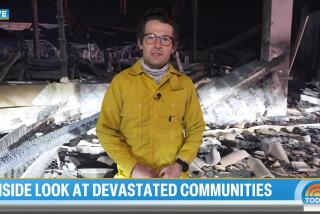Pilot Gave Viewers Show and Rerun : Television: Veteran KNBC helicopter reporter was above scene of both pursuits. If one happens, ‘I want to be there,’ he says.
- Share via
It was a twin bill from the air on Tuesday, and Bob Pettee had the best seat in the house.
The veteran KNBC helicopter pilot-reporter was the first to photograph the police chase that ended in Mission Viejo, and a few hours later he was on the case again above Buena Park.
“I don’t want a pursuit to happen, but if it does I want to be there,” said Pettee, whose morning broadcast interrupted a game show. “About the worst thing that can happen is to be on your way and find the other helicopters on their way back.”
Televised police chases suddenly appear to have become a grim but common part of life in Southern California, like drive-by shootings and earthquakes. But Pettee says that only the quality of chases has changed, not the quantity.
“I think there are more happening that are lasting longer,” he said by air telephone while flying back to Burbank in his Bell 206 Jet Ranger. “I’ve been covering them since 1978, but the pursuits always used to end sooner. It’s the time that they last that lets us get to more of them.”
Why is that happening? Pettee is concerned that fleeing suspects don’t seem to understand the impossible gravity of their actions--and the danger they pose.
“The suspects are somehow confusing fantasy with reality,” he said. “You cannot outrun a police radio. And you can certainly not outrun the CHP. I really praise the Highway Patrol guys now who just let the suspects run out of fuel. When there were no injuries despite speeds over 100 m.p.h., there is a lot of luck involved--but also lot of pure skill.”
Pettee flew helicopters in the Vietnam War. Now 43, he says he’s “addicted to the adrenaline rush” of covering chases with cameraman Dayne Adams and talking about them live on the air. But still, he says: “My main concern is to go home at night.”
Helping him bring the story home safer is a new type of camera, a “gyro-stabilized” Wescam. KNBC bought the camera, which costs well over $100,000, after last year’s riots in Los Angeles because it allows a pilot to fly out of the range of small-arms fire. Other stations continue to use shoulder-mounted cameras that present audiences with a shakier image, Pettee said.
“You can zoom in from 2,000 feet and present as good a picture as if we were at 400 feet,” Pettee said about the new technology. “That lets us stay out of the way of police helicopters--besides getting us a better picture.”
Pettee’s boss is a bit puzzled by the phenomenon of police chases. Mark Hoffman, KNBC’s vice president for news, has only been on the job a few weeks after working for stations in Chicago and Atlanta for the past decade--and is staggered by the frequent use of air reporters to cover police pursuits here.
“My sense is that it’s unique to this marketplace and I haven’t figured out why,” said Hoffman, 36, from Burbank. “Probably it has to do with the lay of the land--the long, wide freeways--as well as the more sophisticated technology.”
He spurned the notion that television is overplaying pursuits to gain viewers.
“It’s not a hard news choice to break in on a game show for a story like this because so many thousands of people are affected while it’s happening and when it ends,” Hoffman said. “The northbound lanes of I-5 were closed for a long time from Mission Viejo to San Clemente and beyond. No one was moving. I think that’s news in this city.”
More to Read
The complete guide to home viewing
Get Screen Gab for everything about the TV shows and streaming movies everyone’s talking about.
You may occasionally receive promotional content from the Los Angeles Times.





